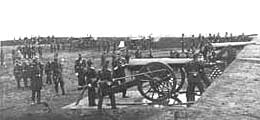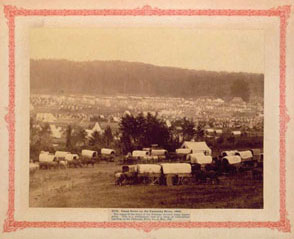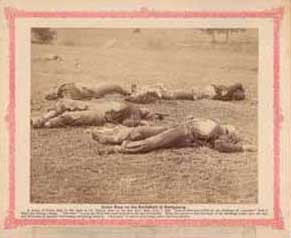The
Civil War demonstrated for the first time how industrial technology
had transformed the nature of warfare. It was the first major
war in which the railroad transported troops and supplies;
railroad junctions, like Chattanooga, Atlanta, and Petersburg
became major military objectives. It demonstrated the superiority
of ironclad ships to those made of wood, thus revolutionizing
naval warfare. The telegraph made instantaneous communication
between generals possible. The war introduced armored trains,
hand grenades, surveillance balloons, and even primitive submarines.
 Perhaps
most important, a revolution in arms manufacturing produced
a more modern rifle, easier to load and deadly at 600 yards
or more because of its grooved (or "rifled") barrel.
This weapon replaced the traditional musket, accurate only
at a short distance, and changed the nature of combat. Heavy
fortifications and elaborate trenches became more important,
giving those on the defensive - usually the Southern armies
- an immense advantage over attacking troops. The rifle reduced
the effectiveness of cavalry charges and made hand-to-hand
combat rare and bayonet wounds almost unheard of.
Perhaps
most important, a revolution in arms manufacturing produced
a more modern rifle, easier to load and deadly at 600 yards
or more because of its grooved (or "rifled") barrel.
This weapon replaced the traditional musket, accurate only
at a short distance, and changed the nature of combat. Heavy
fortifications and elaborate trenches became more important,
giving those on the defensive - usually the Southern armies
- an immense advantage over attacking troops. The rifle reduced
the effectiveness of cavalry charges and made hand-to-hand
combat rare and bayonet wounds almost unheard of.
The
war of rifle and trench produced the appalling casualty statistics
of Civil War battles. At Gettysburg alone there were 50,000
dead, wounded, and missing. The death toll in the Civil War
nearly equals the number of Americans who died in all the
nation's other wars from the Revolution to Vietnam.




